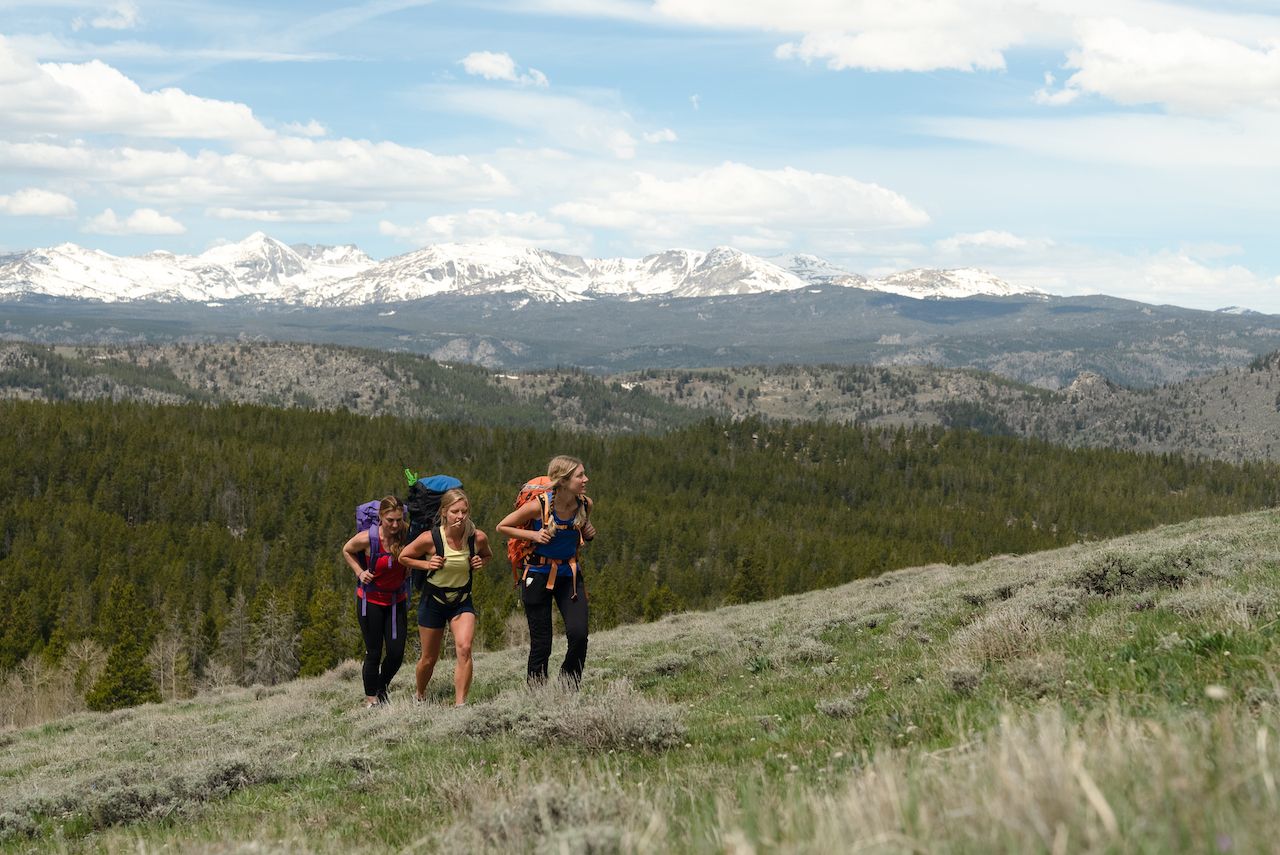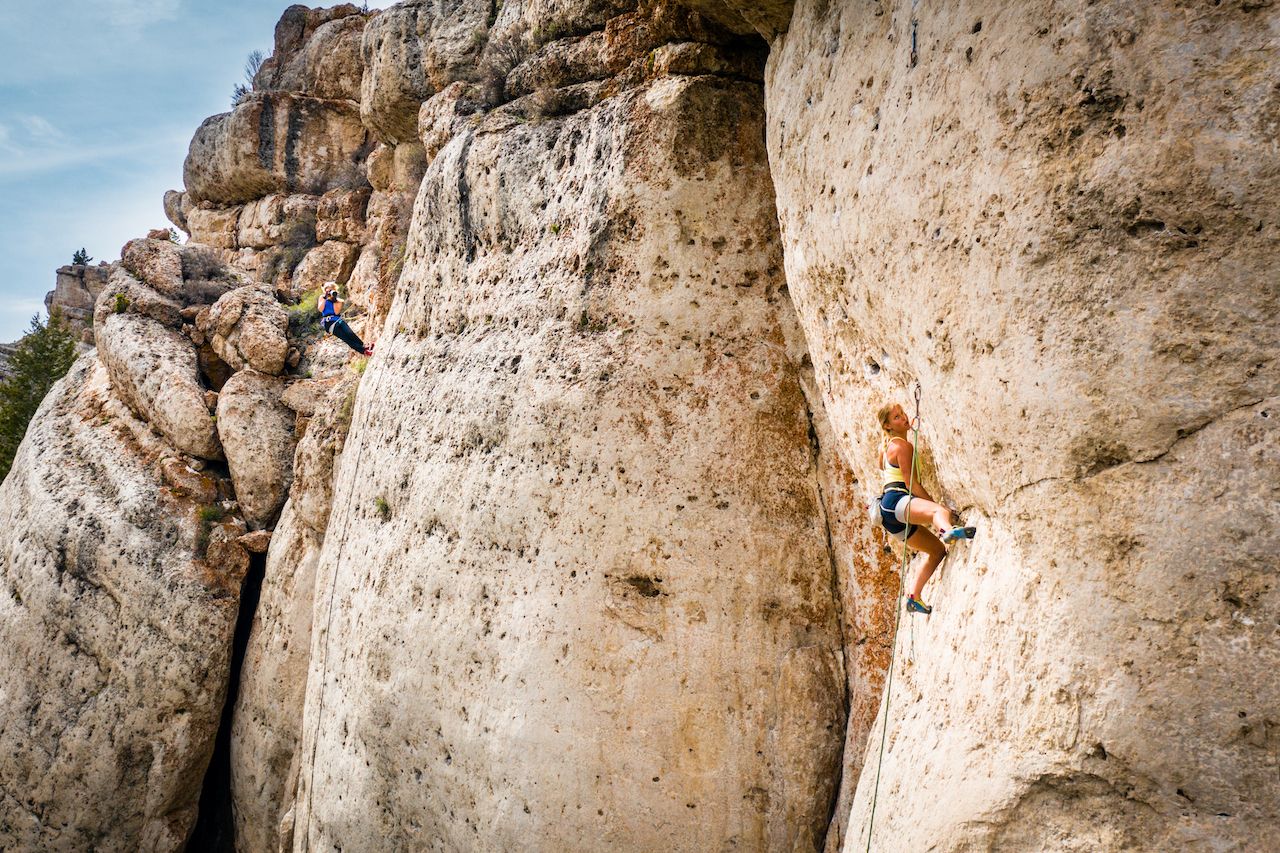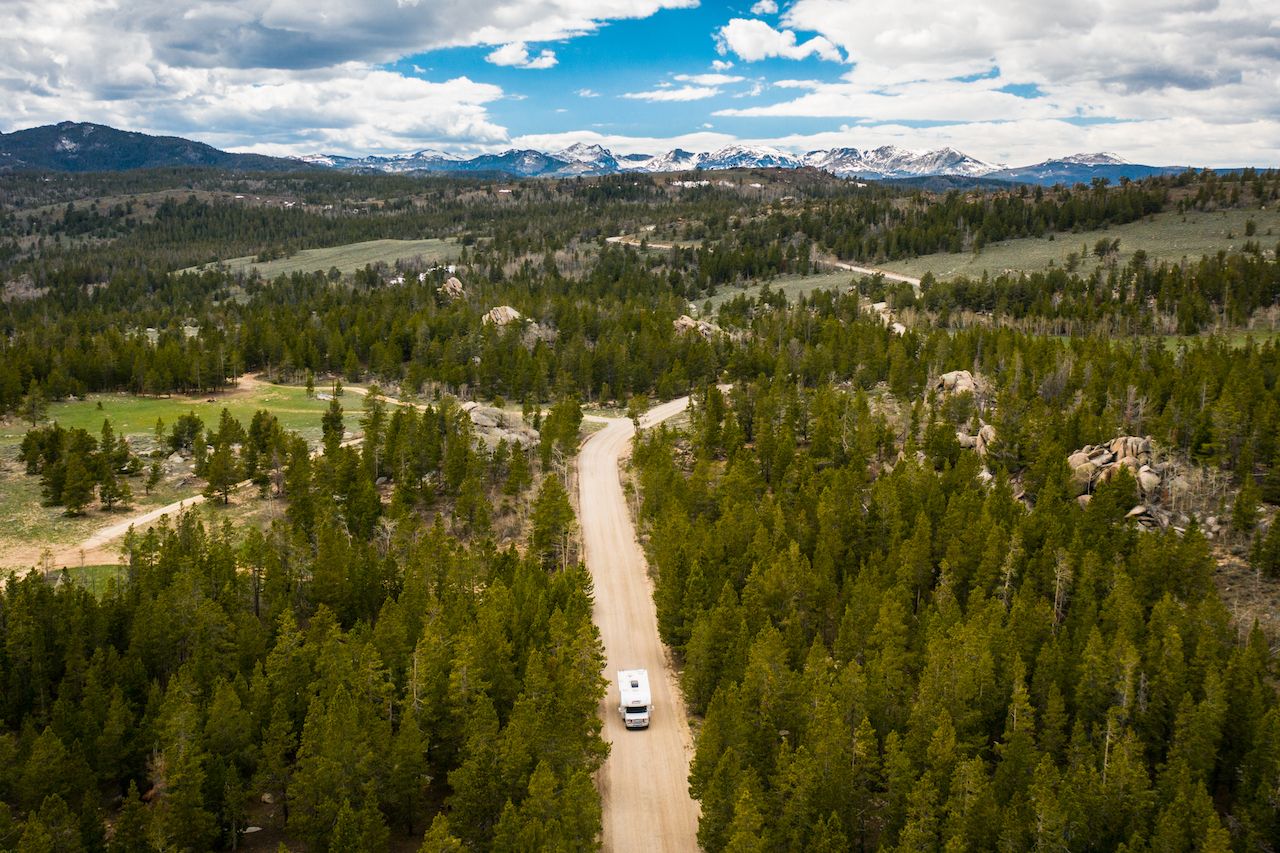At 6,684 feet, the highest point in the eastern US is Mount Mitchell, in North Carolina. Idaho, where I live, has several peaks over 12,000 feet. They’re beasts. Utah’s Wasatch Mountains, where I grew up, reach heights of 13,000 feet. They’re mega-beasts. And when I spend time in Colorado’s Collegiate Peaks for work, I breathe fairly well but my nose tends to bleed. Those peaks are beyond beasts. They’re pushing more than 14,000 feet above sea level.
I share these stats to illustrate why mountains in the East are considered hills in the West. When you go West, you go up. The higher you go, the more you need to plan and prepare — and the more time you need to take it all in. Views above treeline are unmatched; alpine lakes seem almost ethereal. The national parks and forests, the craggy peaks and deep valleys, they all demand your time and attention. And to have that luxury, you’ll want a home on wheels. You’ll want an RV.
Yes, you need to be mindful when camping at elevation, but it’s always worth the extra effort. Here are nine tips for RVing successfully and safely in the mountains.
BEFORE YOU GO

Photo: Brian Lewis
The best way to avoid a mechanical problem on the road is to have your RV inspected before you’re on the road. Camping World Service Centers — there are 170 or so across the country — can do that. If nothing else you’ll come away with peace of mind, and probably some expert opinions and tips on the specifics of your trip.
Next, you’re ready to start packing for your high-elevation expedition.
Tip #1: Pack all the mountain necessities.
First and foremost, plan to haul more water than you think you’ll need. This is both to replenish your body, which will be working harder the higher you go, and to potentially stave off any altitude sickness.
On that theme, you should be well prepared for breakdowns, human or otherwise. Be sure to pack a first-aid kit with enough supplies to care for each person on the trip for four days and a set of tools to fix any basic mechanical mishaps. If your pet is traveling with you, make sure pet essentials, like tick treatment, are in the kit as well.
A snow shovel and scraper — and maybe even some de-icer — fall into the essential category. But I’d draw the line at chains. Yes, it can snow any month of the year in the mountains, but in an RV your response to an oncoming snowstorm should be avoidance — head to a lower elevation immediately.
Tip #2: Don’t pack the extras.
Your RV will have an easier time taking to steep grades with less weight, so try to avoid overpacking for this trip. If you don’t absolutely need it, leave it at home. Each extra pound equals that much more strain on your engine climbing that pass, and that much more fuel burned doing so.
If you’re boondocking, try to fill up your tanks as close to your campsite as possible so you’re not hauling sloshing liquid on windy roads. The same goes for leaving camp — empty the tanks as soon as you can so the ride is easier on your rig. Some RV holding tanks can carry up to 100 gallons. At about eight pounds per gallon, that’s a lot of extra load.
GETTING THERE

Photo: Amon Barker/Apres Visuals
If your homebase isn’t in the mountains, find the longest, hilliest drag you can near home. Familiarize yourself with what your rig feels like going up and down. You have some new skills to build.
Tip #3: Practice downshifting.
Downshifting will be your best friend in the mountains. When going uphill, shift into a lower gear to avoid engine lugging. This is when the engine experiences high load at too low of a RPM. Shifting into a lower gear at the right time will improve gas mileage and prevent engine overheating.
When going downhill, the same rule applies — slow down and downshift. Let off the gas and feel the engine do the work controlling your speed. Don’t ride the brakes, as this can lead to overheating and burn out your brake pads. If your vehicle is steaming under the hood and your brakes aren’t working right, look for a runaway pull-off — usually an unpaved uphill track carved into the mountain for runaway trucks. Use them if you need, but if you follow these tips you shouldn’t have to.
Downshifting applies to motorhome RVers as well as tow-behind travelers. Shifting into a lower gear is how the pro truck drivers do it, and you can too. If you feel like you’re going slower than traffic, that’s okay. Move to a slower lane and take your time, it’s not a race. RVing in the mountains is all about keeping things safe, slow, and steady, whether you happen to be heading up or down.
Tip #4: Know your roads — and yourself.
Consider road conditions as you plan your route. And by “road conditions,” I don’t mean wet or snow-packed surfaces. I mean the actual road bed, not what’s falling on it. Are we talking paved interstate, two-lane highway, groomed gravel, or bumpy dirt? What’s the grade, and what’s the traffic like?
All RV models will travel comfortably on the interstate, but long loads may struggle on winding mountain-pass two-lanes. Groomed gravel is usually graded enough to be level for towed units, but your equipment will only survive a bumpy dirt road if it’s an off-road model. Those have more clearance between the underbelly and the ground.
Your vehicle’s capabilities are important, but so too is your comfort level. Knowing yourself and knowing what you’re looking for always leads to the best adventures.
Tip #5: Know your route.
There’s the fastest way…and then there’s the safest way. When you’re RVing in the mountains, the two are often not the same.
I live in eastern Idaho. Jackson Hole is over the “hill” in western Wyoming, but that hill is a steep climb through the Tetons. The road is often closed in winter and untowable in bad weather. If I’m going to Grand Teton National Park or Yellowstone National Park and I’m pulling a trailer, I don’t take the pass. I detour around Palisades Reservoir. It’s about a half hour longer, but it’s flatter and safer for RVs.
Always check your ego — saving a few miles by taking the steep route is not worth the risk.
BEING THERE

Photo: Brian Lewis
It’s all a balancing act: You’ve taken more time to get up into the mountains, now plan on working with less. That includes fewer people as well as fewer amenities. Crowds and services thin as the air thins. Enjoy the open space, but keep these things in mind before you eye that summit.
Tip #6: Give yourself time to acclimate.
I’m an avid trail racer, and I can always tell who’s from out of town when I reach an aid station above 10,000 feet. Every runner who arrived from low elevation the night before is lying on the ground; they’re lightheaded and can’t seem to catch their breath. For visitors, even a gentle hike through a meadow can have them huffing and puffing as if they were going for a brisk jog. This is normal — the air is thinner, so your lungs have to work harder for oxygen.
Above 12,000 feet, some people need an oxygen tank, but 6,000 to 10,000 is doable by most once you’re accustomed to it. If you’re camped for multiple days, you’ll adjust by day three. Take it easy, and give yourself time to soak it all in.
Tip #7: Don’t be surprised by the physics of high-altitude living.
If you’ve never spent time in the mountains, you might be surprised to learn that, the higher you are, the more time it takes to cook a box of rice pilaf. This is because water boils at a lower temperature when the atmospheric pressure is lower, so the roiling boil in your pot is occurring well below 212 degrees. Similarly, it’s going to take more energy to cool your fridge and heat your RV, so make sure to monitor your propane usage.
As for quirks with how you operate, you should aim to double how much water you drink, even if you don’t feel like you need it. The higher you are, the drier you are — hydration is key to keeping all those bodily processes ticking over. Carry extra water storage, and a water filter, so you’re fully prepared.
GOING HOME

Photo: Brian Lewis
High elevation is invigorating in July, but it’s deadly in January. That’s why you’re not staying up on the mountain for good. Ideally, you come down — remember: slowly! — during the same weather you arrived with. But in the mountains, there’s no guarantee. Keep a constant eye on weather apps, or use a weather radio in case you don’t get service — which is common in the mountains.
Tip #8: Prepare for moisture.
At altitude, you can seemingly endure every season in the same day — maybe even the same hour. That dry, dusty road you drove in on won’t stay dry when it rains. Expect to have to throw on coats and boots at any time, and get used to afternoon afternoon showers. Pack a variety of tactical clothing so you stay comfortable.
Not all weather in the mountains is ominous. Oftentimes a sunshower or light snowfall can create some magical memories. In general, the more you welcome and expect surprises, the smoother your trip will go.
Tip #9: Be ready to move.
Even with all the rain gear in the world, you may still have to break camp if faced with an intense storm. My husband and I had to do this once in the middle of the night with our two little boys in the backcountry. We calmly carried them from our trailer to the backseat of our truck in a downpour in the dark. If we hadn’t bailed before sunrise, we would have had to wait several days for the road to dry before we got out.
In other words, conditions can change quickly and with consequences. Be ready to change with them so your trip on high doesn’t turn into a dangerous downer. After all, you have an RV, so guess what? You can always get back to adventuring — safely — tomorrow.

